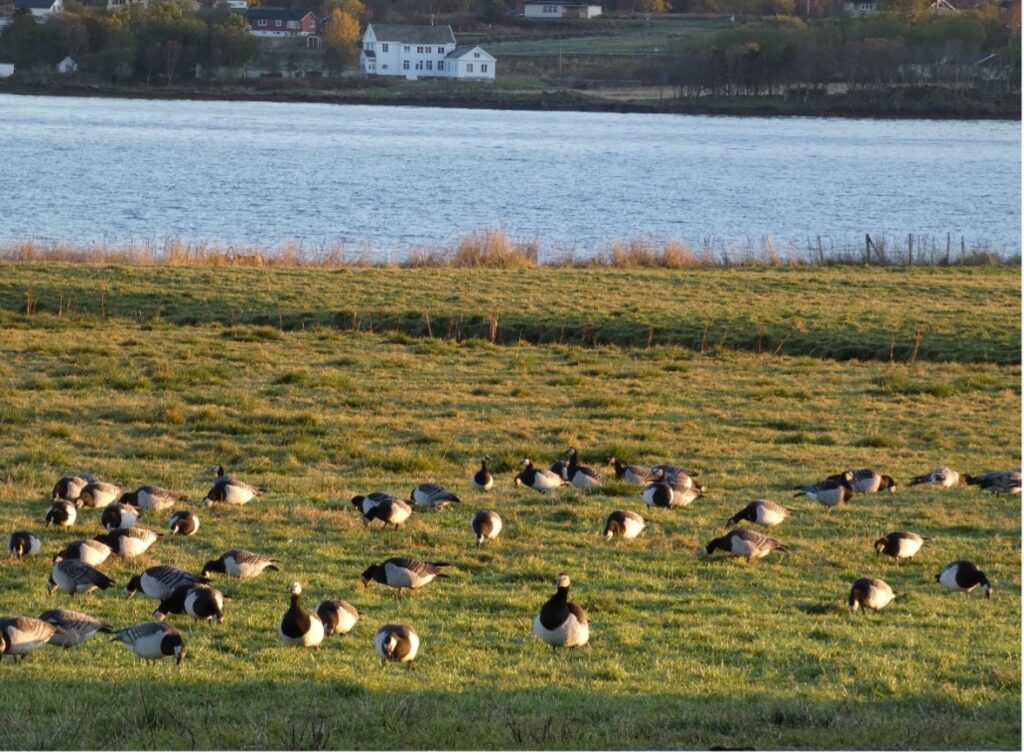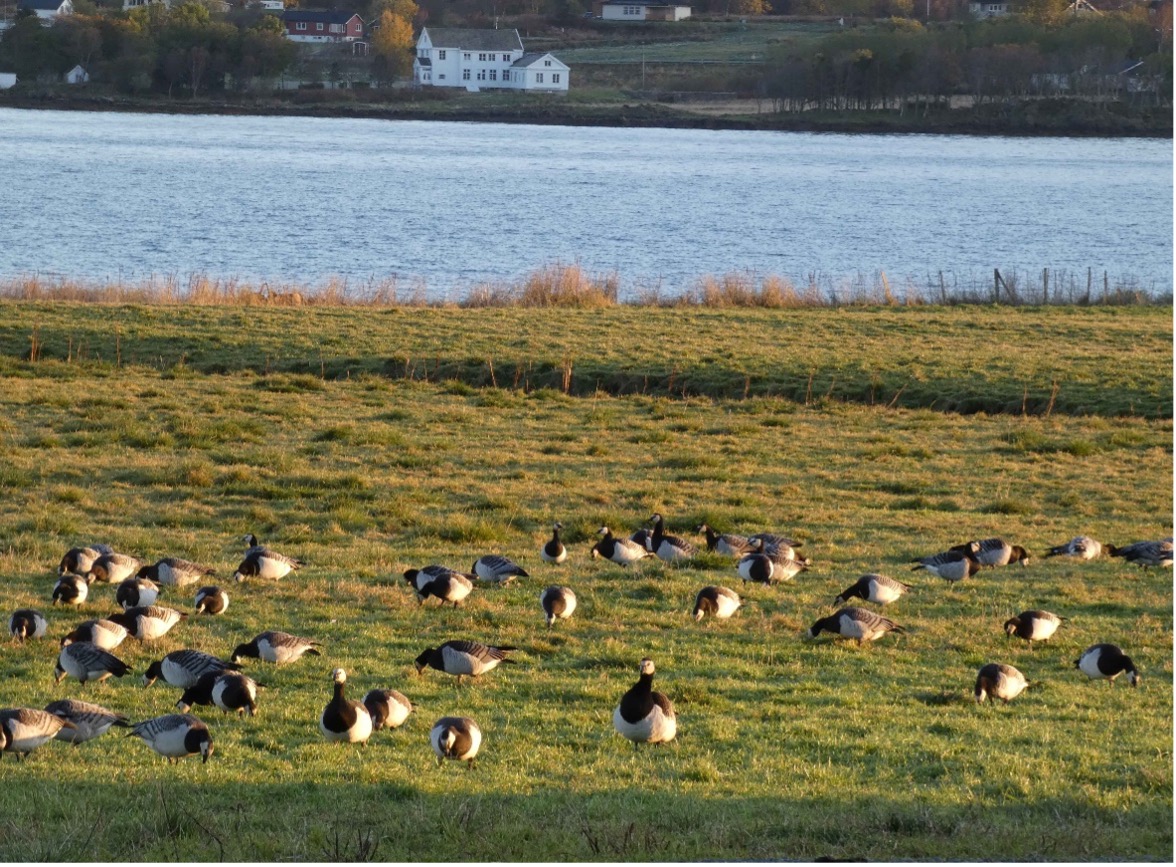Dr Larry Griffin of ECO-LG Ltd, tells us about local geese that are currently visiting Dumfries & Galloway.
By Dr Larry Griffin
With so many geese flying over Dumfries morning and night it is tempting to think that they have all now arrived and have settled into their winter schedules of roosting on the Solway mudflats at night and feeding on the fields inland by day. This obvious activity though masks some more subtle strategies that the geese of the region employ; basically, one of variable timing in migration. Despite all the different goose species of the High Arctic we are familiar with in D&G needing to respond to the same drivers of change such as reduced light levels, food availability and the onset of inclement weather, there are often major differences between them in terms of when they chose to migrate and then, within each species, in terms of the timing of their major movements.
So, even though five pink-footed geese tagged five or six years ago at catches on the Solway or in Lancashire and now dotted elsewhere around the UK as far south as Norfolk represent the flyway population of that species having travelled to Scotland from Iceland in the first couple of weeks of September, other species of goose such as the smaller barnacle geese living in Iceland or Greenland or the larger Icelandic greylag geese and Greenland white-fronted geese have only just started moving south in the last week or two. The barnacle geese moved in big numbers to Islay and Ireland but the Icelandic greylags and Greenland white-fronts moved in much smaller pulses with many of the latter species still being in Iceland.
Of course, in our area on the Solway it is the barnacle geese that arrive from Svalbard that makes the area internationally famous, and these birds tend to arrive from 16th September onwards, that date being consistent across more than 50 years of monitoring as the earliest date that they tend to arrive, with big numbers typically pushing through by the end of the first week of October. Now it is Monday 16th October, and yet within the last three days I heard that there are still decent flocks of barnacle geese above the Arctic Circle north of the Lofoten Islands in Norway, over 1,000 miles away, indeed one of 120 birds spotted has a GPS tag on it.

Such flocks on the ground in northern Norway are not common at this time of year and only occur in some years and will be presumably be pushed out soon by frost and snow, albeit such coastal sites often have their own micro-climate and so the birds might stay put while the grass is still growing. These flocks currently lingering are reported to have a lot of young with them and so perhaps this represents an effort by the parents to further build up the strength of the young birds before attempting the final leg of the migration across the ocean.
Some of these birds however are adult pairs without young and these are the sorts of birds that discover new strategies and ways of living. What if the snows never came or the freeze was not as deep? These birds at such sites could hang on and feed for longer and eventually, although we are a long way from such things yet even with the amplified climate change of higher latitudes, over-winter at such sites. “Short-stopping” further north can reduce the travel risks of heading to the UK for example and shave a couple of thousand miles off the migratory cycle each year and allow birds to get back to the Arctic quicker and get the best nest sites. Such pressures are always acting on these geese and the envelope of what is possible is always being pushed. It does however carry risks though as sudden snow and freezing conditions, or storm systems encountered crossing the Atlantic and North Sea which increase at this time of year in frequency and intensity, could cause such birds to perish if they hang on too long and get pushed out rather than choosing to leave. At such times it is then of course the majority of the birds who followed the traditional routes and timings that get to survive and breed the next year. So, there are always trade-offs and young birds need to learn what works best for them and how to balance the innate and learned aspects that act through hormones on their internal state and decision-making.
Last week on Wednesday 11th , there were 25,000 Svalbard barnacle geese on the Solway and at least 32,000 in the UK as a whole, so it might be expected that between 33,000-35,000 will find their way back to the Solway by mid-winter once these smaller flocks lagging back in Norway head south, and the 2,000 or more that try to over-winter each year on the Northumberland coast at Budle Bay or other estuaries such as Tyninghame Bay east of Edinburgh or Loch of Strathbeg north of Aberdeen finally head southwest to the Solway. These attempted short-stopping strategies on the east coast estuaries are often finally dislodged by a “Beast from the East”!
Now all of the tagged birds of the three key species of Svalbard barnacle goose, resident Scottish greylags and Greenland white-fronted geese are largely on the Solway or elsewhere in Scotland it is well worth checking the GooseNews web maps again hosted by The Stove for this Wild Goose Festival period, as well as the short video-explainer about how to use that resource, as many of the birds will now be in places with which you will be familiar with the landscapes and thus how the geese are operating on a day-to-day basis and what they are experiencing.
For the resident greylags for example, the 11 th was a day of activity for one of the five NTS/Galloway Glens birds as “Cissy” (ringed CCN) decided to do a big circuit of eastern D&G, leaving the Monaive area where it has been based for a few weeks, heading clockwise towards Thornhill and over the hills towards Moffat before turning down south towards Shawhead and then Corsock and then, like a laser-guided goose, back west to the fields at Crossmichael where it was caught during the July moult. There it has become part of a flock with three of the other tagged birds, with only “Cee-Dee” (ringed CDD) left dodging the guns of the Caerlaverock foreshore.
For the Greenland white-fronts, “PIFO53” first caught as a young female back by West Freugh MOD airfield in December 2019, has just headed south from Iceland back to Tiree where it spent last winter, rather than heading further south to West Freugh. Her “mum”, tag “YH” was showing on the web maps in southern Iceland but has been silent since the final days of September. We hope she has not been illegally shot, the fate that sadly befell tag “CLEG04” which we were following on the map, and unfortunately shot last week before completing its 6th full migratory cycle; the loss of a legendary bird caught as a juvenile in February 2018 at Cornabus, Islay, and the end to an amazing record-breaking run of data of such great scientific and conservation value for this rapidly declining and threatened goose population now likely numbering less than 18,000 birds. Tag “YS” a true Loch Ken-ner must also be watched with trepidation in southern Iceland, and we hope she soon gets home safe back to the Blackpark reserve at NTS Threave and the newly restored wetland sites there.
Although we have not heard from Galloway Glens regular “XU” since May when she headed west to Greenland, the old tag on that bird has probably malfunctioned so we will keep an eye out for her too at Loch Ken over the coming months.
On a happier note, with the Svalbard barnacles moving south, at least four of the six tags that were active in May this year after moving out of phone contact, have now been back in contact since reaching the UK and are rapidly downloading their summer and autumn data. As such “green LLT” is visible in Tyninghame Bay and of the other three we know “yellow BDI” for example is somewhere near Anthorn, Cumbria via the GSM phone mast contacts it has made in that area (these less precise locations are not shown on the GPS web maps) and so should be showing GPS data soon for its roosting and feeding movements – one to keep an eye on to discover its amazing migration route…
Enjoy the Festival of Geese this winter!
